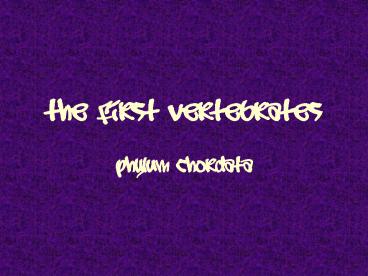The First Vertebrates - PowerPoint PPT Presentation
1 / 25
Title:
The First Vertebrates
Description:
... larvae that resemble tadpoles. Subphylum Cephalochordata. 22 ... BUT the young are tadpole-like. Adult tunicate. Larval tunicate. Reproduction by a juvenile ... – PowerPoint PPT presentation
Number of Views:71
Avg rating:3.0/5.0
Title: The First Vertebrates
1
The First Vertebrates
- Phylum Chordata
2
- Kingdom
- Phylum
- Class
- Order
- Genus
- Species
3
5 Kingdoms10-100 million species
Monera
Protista
Fungi
Plantae
Animalia
4
Kingdom Animalia
- 3-30 million animal species
- A few of the 33 phyla
Annelida
Echinodermata
Arthropoda
Mollusca
Porifera
5
What makes an organism an animal?
- Eukaryotic (cells have a nucleus)
- No cell walls
- Multicellular
- Requires oxygen
- Heterotrophic (cant make its own food like
plants do)
Susan Middleton
6
Phylum Chordata
- 3 Subphyla
- 3.7 of animal species
Urochordata
Cephalochordata
Vertebrata
7
What makes an animal a chordate?(5
characteristics that all chordates have at some
point in their livesmany only as embryos)
- Notochord
- Used to provide rigidity to body
- Present in vertebrate embryos, replaced by
vertebral column later
Vertebral (spinal) column
8
What makes an animal a chordate?
- Dorsal tubular nerve cord
- Dorsal back
- Tubular tube-shaped
- Protected by notochord
- Think spinal cord
9
What makes an animal a chordate?
- Pharyngeal gill slits
- Openings between the pharynx (throat) and the
outside - For filter-feeding in primitive chordates
- Gas exchange in fish and larval amphibians
- Only present in embryos of terrestrial chordates
(and not used for breathing in fetuses)
10
What makes an animal a chordate?
- Segmented, muscular, post-anal tail
- Post-anal means extending out beyond the
digestive system - Yes, humans, too!
11
What makes an animal a chordate?
- Endostyle
- Ciliated, glandular groove on the floor of the
pharynx (throat region) that secretes mucus for
trapping food particles - In vertebrates it is the thyroid gland
12
Subphylum Urochordata2000 species
- Animals called tunicates, or sea squirts
- Marine filter feeders
- Most are sedentary as adults
- Swimming larvae that resemble tadpoles
13
Subphylum Cephalochordata22 species
- Animals called lancelets
- Less than 5 cm long
- Marine filter feeders
- Most are sedentary adults
- Swimming larvae that resemble tadpoles
14
Subphylum Vertebrata7 Classes
Agnatha
Amphibia
Aves
Chondrichthyes
Reptilia
Mammalia
Osteichthyes
15
What makes a chordate a vertebrate?
- Distinct vertebral column (instead of just a
notochord) - Distinct head region (other 2 subphyla do not
have heads) - Distinct skull
- In general, vertebrates are larger and more
active than other chordates
16
According to the theory of evolution
How did this
evolve from this?
sea squirt larva
17
Theories of vertebrate evolution
- There are NO transitional fossils to provide
evidence of an intermediate between invertebrates
and vertebrates - 2 popular theories of vertebrate evolution.
18
The Amphioxus TheorySubphylum Cephalochordata
- Vertebrates may have arisen from an ancestor like
the lancelet species Amphioxus - Small, eel-like animals that burrow in the sand
- Not a popular theory
19
Cephalochordata vs. Vertebrates
- Similarities
- Notochord allows fish-like propulsion
- Closed circulatory system
- Nerve chord expanded at end
- Spinal nerves similar to vertebrates
- Differences
- Excretory system completely different
- Notochord extends too far anteriorly
- Not enough cephalization (head not big enough)
20
The Tunicate Theorysubphylum Urochordata
- Adult sea squirts are very different from
vertebrates - BUT the young are tadpole-like
Adult tunicate
Larval tunicate
21
Paedogenesis
- Reproduction by a juvenile
- Occurs when a larva does not metamorphosize for
some reason, but becomes reproductively mature as
it is - Occasionally occurs in insects and amphibians
22
The tunicate theory
- If paedogenesis occurred in sea squirt larvae,
and the larvae reproduced successfully - then natural selection may have reinforced
this characteristic and the first vertebrate
species would have evolved. - The very first vertebrates were thought to have
been small animals that could absorb oxygen
through their thin skin.
23
Earliest evidence of vertebrates
- 500 million year old fossils from China were
found in late 1990s - 2 species called Myllokumingia and Haikouichthys
- 3cm long, fish-shaped
24
(No Transcript)
25
Vocabulary
- Cartilage
- Multicellular
- Heterotrophic
- Eukaryotic
- Notochord
- Vertebral Column
- Dorsal
- Ventral
- Tubular
- Pharyngeal gill slit
- Larva
- Endostyle
- Sedentary
- Paedogenesis































